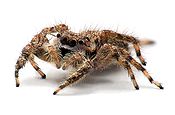- Mygalomorphae
-
Mygalomorphs 
Missulena bradleyi, the Mouse Spider Scientific classification Kingdom: Animalia Phylum: Arthropoda Class: Arachnida Order: Araneae Suborder: Opisthothelae Infraorder: Mygalomorphae Families Mecicobothriidae
Microstigmatidae
Hexathelidae
Dipluridae
Nemesiidae
Theraphosidae
Paratropididae
Barychelidae
Atypidae
Antrodiaetidae
Cyrtaucheniidae
Idiopidae
Ctenizidae
Migidae
Actinopodidae
see Spider families tableDiversity 15 families The Mygalomorphae, (also called the Orthognatha), are an infraorder of spiders. The latter name comes from the orientation of the fangs which point straight down and do not cross each other (as opposed to araneomorph).
Contents
Description
This grouping of several families includes the heavy bodied, stout legged spiders popularly known as tarantulas as well as the dangerous Australasian funnel-web spiders.
Like the "primitive" Mesothelae, they have two pairs of book lungs, and downward pointing chelicerae. Because of this, the two groups were once believed to be closely related. Later it was realized that the common ancestors of all spiders had these features (Symplesiomorphy), and that the mygalomorphs just retained them, while the closely related araneomorphs evolved new features (including a cribellum) (Coddington & Levy, 1991).
Almost all species of Mygalomorphae have eight eyes, however there are some with fewer (Masteria lewisi has only six eyes).
They have ample venom glands that lie entirely within their chelicerae, but only spiders of the Australian genus Atrax can be really harmful to humans. Their chelicerae and fangs are large and powerful. Occasionally members of this suborder will even kill small fish, small mammals, and the like.
While the world's biggest spiders are mygalomorphs - Theraphosa blondi (Latreille, 1804) has a body length of 10 cm, and a leg span of 28 cm - some species are less than one millimeter long. Mygalomorphs are capable of spinning at least slightly adhesive silk, and some build elaborate capture webs that approach a meter in diameter (Coddington & Levy, 1991).
Unlike Araneomorphae, which die after about a year, Mygalomorphae can live for up to 25 years, and some don't reach maturity until they are about six years old.[1] Some flies in the family Acroceridae which are endoparasites of mygalomorphs may remain dormant in the book lungs for as long as 20 years before beginning their development and consuming the spider.
Evolution
Sphodros rufipes, an atypical tarantula
Megarachne servinei was thought to be a giant mygalomorph from the Upper Carboniferous (ca. 350 million years ago), but was later found to be an eurypterid (Selden et al., 2005a). Thus, the oldest known mygalomorph is Rosamygale grauvogeli Selden & Gall, 1992 (Hexathelidae) from the Triassic of north-east France. No mygalomorphs from the Jurassic have yet been found. (Selden et al., 2005b).
Distribution
Most members of this infraorder occur in the tropics and subtropics, but their range can extend farther north, e.g. into the southern and western regions of the United States.
Only few species occur in Europe. These are of the families Atypidae, Nemesiidae, Ctenizidae, Hexathelidae, Theraphosidae and Cyrtaucheniidae, together with only a dozen species.
However, it is suggested that the Mygalomorphae were distributed world-wide before the breakup of Pangaea (Selden et al., 2005b).
Mygalomorphae Atypidae
Mecicobothriidae
Theraphosidae
Cyrtaucheniidae
Ctenizidae
Cladogram of the group[2]
References
- ^ About Spiders
- ^ Coddington, J.A. 2005. Phylogeny and Classification of Spiders. In D. Ubick, P. Paquin, P. E. Cushing, and V. Roth (eds.) Spiders of North America: an identification manual, American Arachnological Society. 377 pages. Chapter 2, pp. 18-24.
Other sources
- Raven, R.J. (1985). The spider infraorder Mygalomorphae: Cladistics and systematics. Bull. Am. Mus. Nat. Hist. 182:1-180.
- Coddington, J.A. & Levi, H.W. (1991). Systematics and Evolution of Spiders (Araneae). Annu. Rev. Ecol. Syst. 22:565-592.
- Goloboff, P.A. (1993). A Reanalysis of Mygalomorphae Spider Families (Araenae). American Museum Novitates 3056. PDF
- Selden, P.A., Corronca, J.A. & Hünicken, M.A. (2005). The true identity of the supposed giant fossil spider Megarachne. Biology Letters 1: 44-48. doi:10.1098/rsbl.2004.0272
- Selden, P.A., da Costa Casado, F. & Vianna Mesquita, M. (2005). Mygalomorph spiders (Araneae: Dipluridae) from the Lower Cretaceous Crato Lagerstätte, Araripe Basin, North-east Brazil. Palaeontology 49(4): 817-826. doi:10.1111/j.1475-4983.2006.00561.x
External links
- Taxonomy, husbandry and captive breeding of Dipluridae
- Mygalomorphae or primitive spiders
- Suborder Mygalomorphae
Spiders Arachnology 
Taxonomy Araneomorphae · Mesothelae · Mygalomorphae · Opisthothelae · List of families of spiders · Lists of spider speciesAnatomy Arthropod leg · Book lung · Calamistrum · Cephalothorax · Chelicerae · Cheliceral fang · Cribellum · Epigyne · Exuvia · Opisthosoma · Pedipalp · Scopulae · Silk · Spinneret · Urticating hairHuman interaction Webs Spider web · Web decorationsCategory Categories:
Wikimedia Foundation. 2010.


